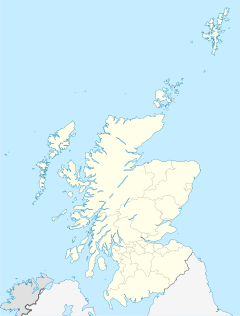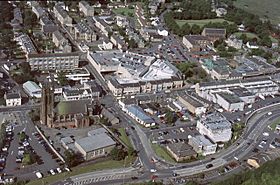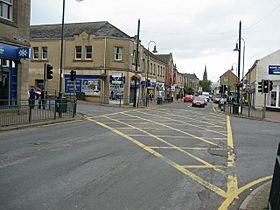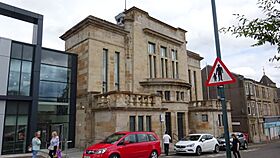Kirkintilloch facts for kids
Quick facts for kids Kirkintilloch
|
|
|---|---|
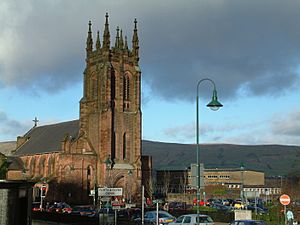 St Mary's Church in Kirkintilloch's Cowgate |
|
| Population | 21,870 (2020) |
| OS grid reference | NS655735 |
| Lieutenancy area | |
| Country | Scotland |
| Sovereign state | United Kingdom |
| Post town | Glasgow |
| Postcode district | G66 |
| Dialling code | 0141 |
| Ambulance | Scottish |
| EU Parliament | Scotland |
| UK Parliament |
|
| Scottish Parliament |
|
Kirkintilloch is a town in East Dunbartonshire, Scotland. It sits beside the Forth and Clyde Canal and is about 8 miles (13 km) northeast of Glasgow. Historically, Kirkintilloch was part of Dunbartonshire. Today, it is the main administrative center for the East Dunbartonshire council area. In 2011, the town had a population of around 19,689 people. Locals often call it Kirkie or Kirky.
Contents
- Understanding the Name Kirkintilloch
- A Glimpse into Kirkintilloch's Past
- How Kirkintilloch is Governed
- Kirkintilloch's Location and Surroundings
- Culture and Community Life
- Schools and Learning
- Local News
- Famous People from Kirkintilloch
- Sports in Kirkintilloch
- Places of Worship
- Twin Town
- Images for kids
- See also
Understanding the Name Kirkintilloch
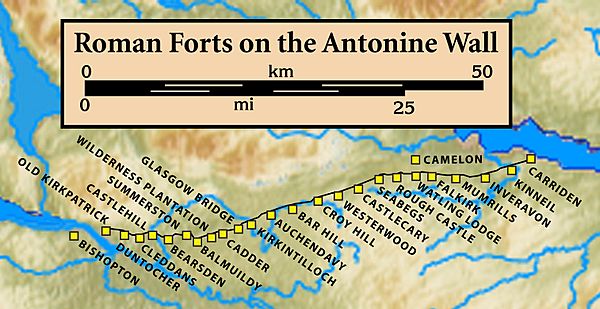
The name "Kirkintilloch" comes from the Gaelic words Cair Cheann Tulaich. This means "fort at the end of the hill." It might also come from an older language called Cumbric, with a similar meaning.
This name likely refers to an old Roman fort that was built on a hill. This hill offered a great view for many miles around. Sometimes, people jokingly say the name means "church in the field."
A Glimpse into Kirkintilloch's Past
The first known settlement in Kirkintilloch was a Roman fort. It was built in the mid-2nd century in what is now Peel Park. The Antonine Wall, a northern border of the Roman Empire, ran right through Kirkintilloch. You can still see some traces of it today. Many Roman items found here are now in the Hunterian Museum in Glasgow.
After the Romans, there isn't much evidence of people living here for about 1,000 years. Then, in the 12th century, the Clan Cumming built a castle and a church. A small town grew around them and became a "burgh" (a town with special rights) in 1211. It was an important stop for travelers going between Glasgow and eastern Scotland.
The Castle and Scottish Wars
The castle was important during the Wars of Scottish Independence. English soldiers stayed there, and they even helped arrest William Wallace in 1305. Later, Scottish forces attacked the castle but couldn't capture it. The castle was likely destroyed by Robert Bruce during the wars. Today, you can still see the remains of a mound and ditch in Peel Park.
Churches and Parishes
The first church, St Ninian's, was built around 1140. It was part of a larger area called Lenzie. Later, a chapel dedicated to the Virgin Mary was built in the town itself. In 1644, the main church moved to the chapel's site, which is now the Auld Kirk Museum. This move split the Lenzie area into two parishes. The name Lenzie was later used for Kirkintilloch's railway station.
Changes in Control
After Scotland won the wars of independence, Robert Bruce gave the lands of Kirkintilloch to Sir Malcolm Fleming. This area, which was once part of Stirlingshire, then became part of Dunbartonshire.
The Jacobite Army Passes Through
On January 3, 1746, the Jacobite army, led by Charles Stuart, marched through Kirkintilloch. They were returning from England. One of their soldiers was shot in the town. Charles Stuart threatened to burn the town, but the town leaders convinced him to continue marching by offering a payment.
The Industrial Revolution
Kirkintilloch became a busy center during the Industrial Revolution.
- Textile Industry: By 1790, there were many weavers in the town.
- Transportation: The Forth and Clyde Canal opened in 1773, and the Monkland and Kirkintilloch Railway in 1826. This made Kirkintilloch an important hub for transport and trade.
- Manufacturing: The town became known for producing iron, coal, nickel, and even small ships.
- Famous Exports: Kirkintilloch was famous for making the distinctive red British post boxes and phone boxes until 1984.
A "Dry Town" History
For a long time, from 1923 to 1967, Kirkintilloch was a "dry town." This meant that alcohol could not be sold in public places. This ban was supported by groups who believed alcohol had negative effects on the community.
Growth in the 20th Century
In the 1960s, Kirkintilloch grew as people moved from Glasgow. Many new houses were built, and the town's population increased to its current levels.
How Kirkintilloch is Governed
Kirkintilloch used to have its own town council. In 1975, it became part of the Strathkelvin local government district. Then, in 1996, East Dunbartonshire council was formed, and Kirkintilloch became its main administrative center. The council's headquarters are now in the William Patrick Library.
Kirkintilloch's Location and Surroundings
The Forth and Clyde Canal and the Luggie Water both flow through Kirkintilloch. The canal crosses the Luggie Water on a special bridge called an aqueduct. The Luggie Water then flows into the River Kelvin, which eventually joins the River Clyde in Glasgow.
Many smaller communities are located in and around Kirkintilloch, including:
- Cleddans
- Harestanes
- Hillhead
- Oxgang
- Waterside
- Lenzie
Culture and Community Life
Kirkintilloch Town Hall
The Kirkintilloch Town Hall opened in 1906. It was closed for a while but reopened in November 2018 after major restoration work. It is now used for community events.
William Patrick Library
The William Patrick Library is the main library for East Dunbartonshire. It moved to a new building in the 1990s. The library is named after a local minister, William Patrick, whose brother helped fund its creation. Today, it also houses other council offices.
Shopping and Recreation
After the Second World War, Kirkintilloch grew, and new facilities were built. Shopping areas were developed, and the Regent Centre shopping mall opened in the 1990s.
A new leisure center opened in Woodhead Park in July 2007. It offers facilities for swimming, tennis, badminton, football, and a gym. There is also a large children's play area in the park.
Festivals and Music
Kirkintilloch hosts a cultural festival called G66+ Live! in June, with talks, music, and dramas. The town's brass band, the Kirkintilloch Band, has won Scottish championships. Each August, the local Canal Festival takes place, celebrating the town's connection to the waterway.
Theatre and Pipe Band
The Kirkintilloch Players, an amateur theatre group, performs at the Turret Theatre. The Kirkintilloch Pipe Band, established in 1888, also performs at local events and competitions.
Schools and Learning
Kirkintilloch has several primary schools:
- Hillhead
- Holy Trinity
- Harestanes
- Oxgang
- Gartconner
- Lairdsland
- Holy Family
There are also two schools for children with special needs: Merkland School and Campsie View School.
The two secondary schools are:
- Kirkintilloch High School (non-religious)
- St Ninian's High School (Roman Catholic)
Both high schools moved into new buildings in 2009.
Local News
The local newspaper for Kirkintilloch is the Kirkintilloch Herald. It was first published in 1883.
Famous People from Kirkintilloch
Many notable people have connections to Kirkintilloch, including:
- Moira Anderson, a singer
- Alexander Bain, inventor of an electric clock
- Archibald Scott Couper, a chemist
- Tom Johnston, a Labour politician and former Secretary of State for Scotland
- Rita Taketsuru, a pioneer in Japanese whisky
- Jim Watt, a boxer
Sports in Kirkintilloch
Kirkintilloch has a football club called Kirkintilloch Rob Roy F.C., which has won the Scottish Junior Cup three times. They now play at the town's Community Sports Complex. Another amateur team, Harestanes A.F.C., has won the Scottish Amateur Cup three times.
Lenzie RFC is a rugby club based in the town. A new swimming pool and gym opened in Woodhead Park in 2007. The town also has an athletics club called the "Kirkintilloch Olympians."
Famous footballers like Gregg Wylde and Charlie Mulgrew have connections to Kirkintilloch. Lenzie Youth Club is a local football club that has trained players like Barry Bannan and Stephen Crainey.
Places of Worship
Kirkintilloch has several churches:
- Church of Scotland: St Mary's, St David's Memorial Park, and St Columba's.
- Baptist: Churches at Townhead and Harestanes.
- Roman Catholic: St Flannan's and Holy Family and St Ninian's.
- Jehovah's Witnesses: A congregation that shares a Kingdom Hall.
Twin Town
Kirkintilloch is twinned with:
- Yoichi, Hokkaido, Japan
Images for kids
See also
 In Spanish: Kirkintilloch para niños
In Spanish: Kirkintilloch para niños


